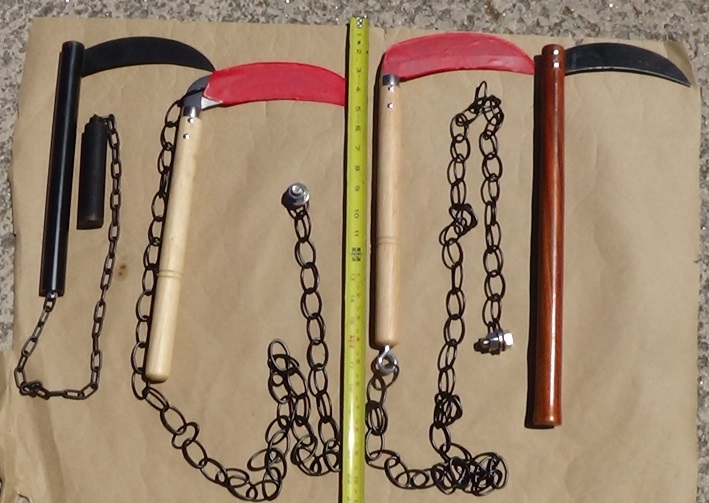|
Weapons - Kama (continued) |
| The two kamas in
the middle have sharpened blades and were photographed with red
safety covers on the blades. |
| Note that the
handles have different lengths. In real life (harvesting rice)
the short black handle (leftmost) is probably |
| most commonly
encountered as one would be bent over to grip the rice stalk or
stalks near where they will be cut. |
| The ability to
tuck the chain away dry and out of sight is desirable as rice
paddies and metals are not best of friends. |
| However, the
relatively short shaft and the short chain give up a reach
advantage to what might be called medium |
| length weapons
like a sword (jian) or saber (dao). The shorter lengths provide
some leverage tradeoffs against longer |
| weapons like
staff, spear and kwan dao. The two kamas in the middle are
different: one has a chain attached at the |
| base of the blade;
while the other has the chain attached at the end of the handle.
One key consideration when the |
| chain is attached
at the base of the handle is that the longer the handle the
shorter the reach of the chain. In a manner |
| similar to the
changes we made to tonfas (longer and thicker, so safer albeit
heavier), the kama as commonly built |
| is too short and
too thin to protect the forearm. The weight on the chains of the
two center kamas is a one inch hex bolt |
| with two washers
and a nut. One can use other gizmos as a weight, and the nut and
bolt can be supplemented with |
| Loctite ®
Threadlocker Blue 242 from Henkel Corporation (neighbors in Bay
Point). Note that Threadlocker contains |
|
methacrylate ester so read the directions. |
| We tried several
chains varying the length and the thickness (hence, the weight
and speed). One consideration is what |
| you are doing
with the chain: it can be thrown or whirled in a circle. If
thrown, especially if thrown backhanded, |
| you would likely
want the weight at the end arriving at the enemy quickly and
with impressive mass. In that case one |
| would want a
comparatively heavy weight and a light chain which is eight to
twelve feet long. If the chain and weight |
| are instead being
whirled in a circle there are two limits imposed on the length
of the chain: /1/ it is undesirable for the |
| weight to strike
the ground which means if one spins at shoulder height and
manages to angle the plane of the spin to be |
| around 45 degrees
about seven feet of chain and weight can be spun /2/ while the
weight and chain are spinning away |
| from your
defensive area (perhaps as much as 75% of the swing) you are
vulnerable. Let us imagine the kama itself is |
| in your left hand
with a chain extending from the kama to your right hand. If you
throw the weight and the chain your |
| right hand is
isolated, so you need to either withdraw it or advance with your
left foot. In either case, if the weight does |
| not damage or
deter the opponent the counterattack by the opponent is going to
cause serious defensive challenges. The |
| kama as usually
built only has one edge sharpened so that limits what can be
done with it. The engineering of putting a |
| spike or knife
blade on the tip of the handle is somewhat complex - and would
not have been tolerated by Japanese |
| samurai occupying
Okinawa and other southern islands. We are NOT convinced the
kama, with or without a chain, is |
| an effective
weapon, and it looks unlikely that we will teach it. However,
the manriki (the chain by itself) might be |
| useful as part of the
wheelchair curriculum. |
